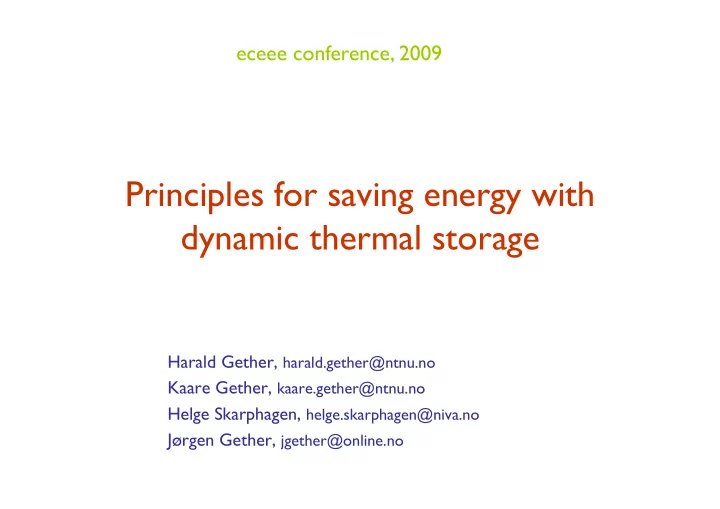

eceee conference, 2009 Principles for saving energy with dynamic thermal storage Harald Gether, harald.gether@ntnu.no Kaare Gether, kaare.gether@ntnu.no Helge Skarphagen, helge.skarphagen@niva.no Jørgen Gether, jgether@online.no
Agenda Not Used Energy (NUE) or Negawatts Energy from variation in temperature A systems approach Transfer and storage of heat and cold Dynamic thermal storage (DTES) Synergy with borehole thermal storage (BTES) Saving energy Saving when available for use when needed Getting rid of excess heat at night Economic savings (from off-peak electric tariffs)
Not Used Energy (NUE) / Negawatts Advantages: Reduced CO 2 or increased utility through ”rebound” Energy available to others Elimination of all upstream losses Free energy (for ever) once facilities are paid for Innovation: Macroeconomic gain relative to power plants and burning of fuels Convertible to saleable commodity through societal measures similar to CO 2 -quota systems
SINTEF – Norway 2008
Temperature variation and demand for electric power Oslo, January – June
Principal integration of dynamic thermal storage (DTES) into buildings Electronically controlled displacement Heated pumps room air Controlled Room by user Water 24C air 21C Controlled by system Outdoor mild weather E C Water 35C Heat pump DTES
Borehole thermal storage (BTES) for large capacity and regeneration 13 4,5m 4 5 m s 5m 5m 5,5m 3 1 Store cold in centre for cooling in warm climates Reverse direction of flow for retrieval of heat
Transfer of heat/cold The importance of efficient heat exchange - with heat pumps we pay for every degree Transferred heat: c v = spec. heat of transfer medium m = mass of transfer medium Q = c v * m * (t 2 -t 1 ) (t 2 -t 1 ) = temperature drop in transfer medium from source to delivery. Energy lost in transfer: There is a temperature drop in the heat exchanger from source to transfer medium, and a second drop from transfer medium to receiving medium. These drops should be kept low relatively to (t 2 – t 1 )
Using mild weather when cold
Cooling at night for more efficient air-conditioning Day temp. 36 C Day temp. 30 C Day temp. 24 C Gain factor Day temp. 30 C. no heat distribution within building Temperature at night
Traditional diurnal pattern of consumption of electric power
Economic gains from using electric power at low tariffs
Practical implementation Laboratory experiments confirm stable, low-loss separation of warm and cold heat transfer medium in DTES storage. Installation costs are presently under evaluation. Modelling indicates about twice the efficiency of ordinary heat pump technology. Ability to use night tariffs for electricity creates runtime economics of about six times that of traditional air conditioning.
Thank you for your attention Kaare Gether Harald Gether kaare.gether@ntnu.no harald.gether@ntnu.no Jørgen Gether Helge Skarphagen jgether@online.no helge.skarphagen@niva.no
Recommend
More recommend